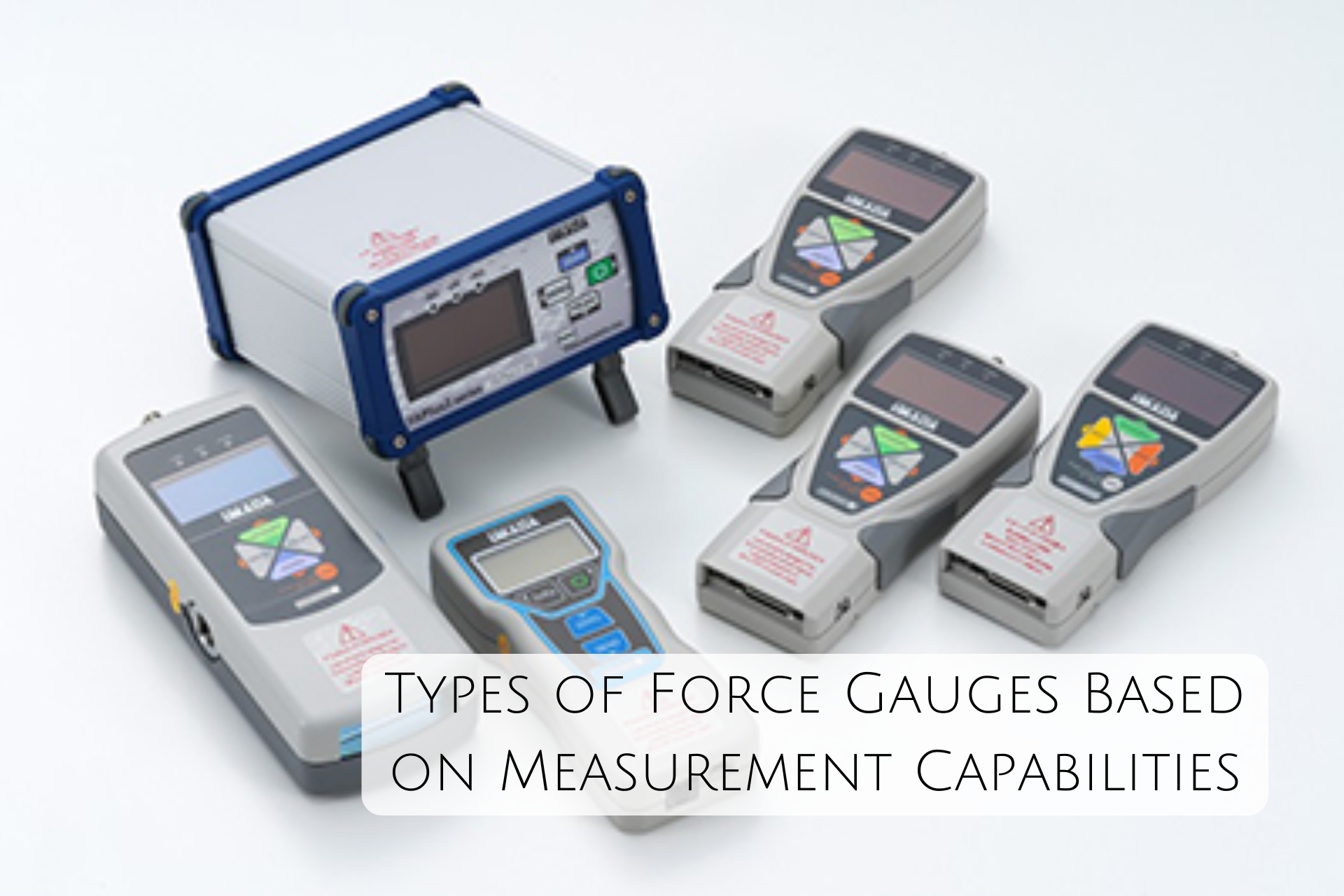Understanding Force Gauges: How and When to Use Them in Industry
Force gauges are essential tools in industrial settings, designed to measure force or load applied to an object. They play a crucial role across industries such as manufacturing, quality control, research, and development, ensuring safety, quality, and performance. In this article, we’ll explore what force gauges are, the types available, and practical applications, highlighting how they contribute to operational efficiency and product reliability.
What is a Force Gauge?
A force gauge is a device that quantifies the force exerted on an object, typically in units of Newtons (N), pounds-force (lbf), or kilograms-force (kgf). Force gauges measure push (compression) and pull (tension) forces, providing valuable insights into the performance and durability of materials, components, and systems.
There are two main types of force gauges:
- Mechanical Force Gauges: These are analog instruments that use springs or levers to measure force. They are often simple, durable, and suitable for applications where precision isn’t critical.
- Digital Force Gauges: Digital gauges are more advanced, offering higher accuracy and data storage capabilities. They display measurements electronically and often feature additional functionalities, such as real-time tracking, peak measurement, and data export.
Types of Force Gauges Based on Measurement Capabilities:
Force gauges can also be categorized by their specific measurement capabilities:
- Compression Force Gauges: Designed to measure compressive forces, they are commonly used in testing applications where the object is pushed or pressed.
- Tension Force Gauges: These measure tensile forces, ideal for applications involving pulling or stretching, such as cable and wire testing.
- Dual Capacity Gauges: These versatile gauges can measure both compression and tension, making them suitable for a broader range of applications.
Key Applications of Force Gauges in Industry:
Force gauges are used in various industrial applications to ensure product quality, improve safety, and support research and development. Here are some of the primary uses:
1. Quality Control and Testing:
Quality control is a significant area where force gauges are used to verify the strength, durability, and performance of products. For example:
- Material Testing: Force gauges help determine the tensile strength, elasticity, and breaking point of materials, such as metals, plastics, and rubber.
- Component Testing: Manufacturers use force gauges to test the strength of springs, fasteners, and other components to ensure they meet design and performance standards.
- Adhesive Testing: For products with glued or bonded parts, force gauges measure the force needed to separate them, ensuring that adhesives are strong enough for the intended application.
2. Manufacturing and Assembly:
In the manufacturing and assembly stages, force gauges are used to check force exerted on parts to prevent over-tightening or under-tightening. For example:
- Torque and Fastener Testing: Force gauges verify the force used to tighten bolts, screws, and nuts, ensuring assembly accuracy and avoiding component failure.
- Press Fit Testing: Force gauges monitor the force needed for press-fit components to ensure proper assembly and prevent damage to parts during production.
3. Automotive Industry:
In the automotive industry, force gauges help ensure the safety and durability of vehicle components. They are used to test:
- Seat Belt Tension: Force gauges measure the tension of seat belts to ensure they meet safety standards.
- Spring and Suspension Testing: By assessing spring tension and suspension forces, manufacturers ensure a smooth and safe ride.
- Brake Pedal Force: Measuring brake pedal force helps verify that braking systems are effective and meet required specifications.
4. Pharmaceuticals and Packaging:
Force gauges play a role in the pharmaceutical and packaging industries, ensuring product safety and package integrity:
- Tablet Hardness Testing: To ensure that tablets don’t break or crumble during handling, force gauges measure the hardness of tablets.
- Package Seal Strength: Force gauges test the strength of seals on packaging to prevent leaks and contamination, especially for food and pharmaceutical products.
- Bottle Cap Tightness: In the beverage and medical industries, force gauges help verify that caps are sealed with the correct amount of force to avoid leakage.
5. Consumer Electronics and Appliances:
Force gauges help improve the durability and functionality of consumer electronics and appliances by testing components such as:
- Button Resistance: Force gauges measure the actuation force for buttons and switches, ensuring they provide consistent feedback and function over time.
- Touchscreen Durability: For devices with touchscreens, force gauges are used to test the durability of screens against applied pressure.
- Assembly Quality: Force gauges assess whether parts are assembled with sufficient pressure, preventing loose or improperly attached components.
When and How to Use Force Gauges:
Understanding the correct use of force gauges is critical to achieving accurate and reliable measurements. Here are best practices for using force gauges effectively:
1. Choosing the Right Gauge:
Select a gauge suited to your application based on the force range, precision, and type (compression, tension, or dual capacity). For high-precision requirements, digital force gauges are typically the best choice.
2. Calibrating the Gauge:
Regular calibration is essential to ensure accurate readings. Force gauges should be calibrated according to the manufacturer’s instructions and industry standards, as uncalibrated gauges can yield unreliable results.
3. Setting Up Properly:
Proper setup is crucial. Ensure the force gauge is securely mounted or positioned to avoid movement or vibration during measurements. When measuring force in a specific direction, make sure the gauge is aligned accordingly.
4. Using Accessories and Fixtures:
Using accessories like grips, clamps, and fixtures can enhance measurement accuracy and ensure the gauge interacts with the object in a controlled manner. Choose accessories compatible with your force gauge and the material being tested.
5. Recording and Analyzing Data:
Digital force gauges often feature data storage, making it easy to track and analyze force data over time. Regular data review can reveal trends and help identify potential quality issues early.
Benefits of Using Force Gauges:
Force gauges offer numerous advantages in industrial settings, helping improve product quality, safety, and efficiency:
- Improved Product Quality: Consistent force measurements ensure components meet specifications, resulting in better quality products.
- Enhanced Safety: In industries like automotive and electronics, force gauges help ensure components function safely, reducing risk of accidents or failures.
- Cost Savings: By ensuring correct assembly and reducing defects, force gauges help lower maintenance costs and minimize product recalls.
- Data-Driven Insights: Digital force gauges provide valuable data, allowing manufacturers to track performance trends and make informed adjustments to production processes.
The Future of Force Gauges in Industry:
As industrial processes advance, force gauges continue to evolve with enhanced digital capabilities, improved accuracy, and user-friendly interfaces. New developments include:
- Integration with IoT: Force gauges are being designed with IoT capabilities, enabling remote monitoring and real-time data sharing, which is valuable in automated manufacturing environments.
- Wireless Operation: Wireless force gauges allow for flexibility in testing hard-to-reach areas without the need for cumbersome cables.
- Enhanced Data Analysis: With more sophisticated data storage and analysis capabilities, force gauges provide deeper insights into force measurements, making it easier to maintain quality and prevent failures.
Conclusion:
Force gauges are indispensable in modern industry, offering precision measurements that ensure quality, safety, and efficiency. Whether in manufacturing, automotive, packaging, or electronics, these devices play a critical role in testing, quality control, and assembly. As technology advances, force gauges will continue to be a valuable tool for companies looking to maximize product performance and protect their investments. By understanding and using force gauges effectively, industries can enhance operational performance and maintain a competitive edge.
Latest Blogs
Traveling with Your Dog: Essential Supplies for Safe Adventures
Traveling with your dog can be an incredibly rewarding experience, whether you’re heading to a new c...
Understanding Blade Angles: How They Affect Performance and Usage
Blade angle, often referred to as "bevel angle," plays a critical role in the efficiency and versati...
The Best Power Tools for Home Renovation: A Comprehensive Guide
Embarking on a home renovation project is exciting, but it’s also a big undertaking that requires th...
Tech in the Garden: The Rise of Smart Gardening Tools
Gardening has traditionally been a relaxing, nature-centric hobby, but with recent advancements in t...
Tech in the Garden: The Rise of Smart Gardening Tools
Gardening has traditionally been a relaxing, nature-centric hobby, but with recent advancements in t...
Security Lighting and Motion Detectors: An Underrated Defense Mechanism
When it comes to home security, many people focus on locks, alarms, and surveillance cameras. Howeve...






